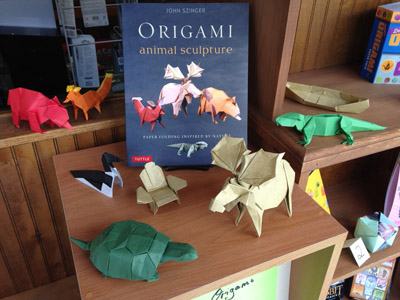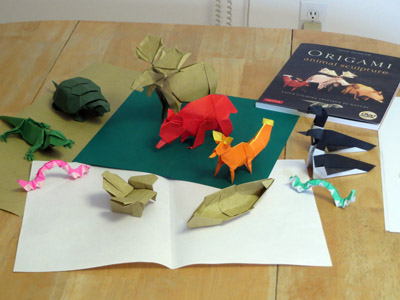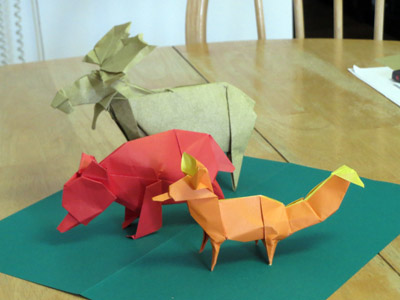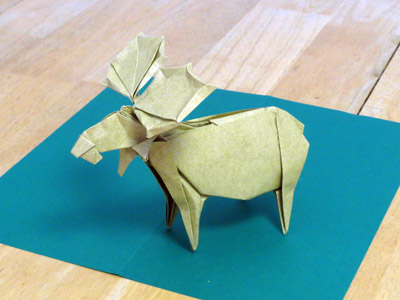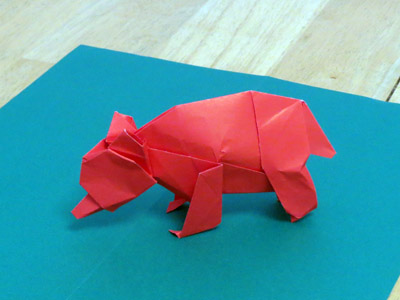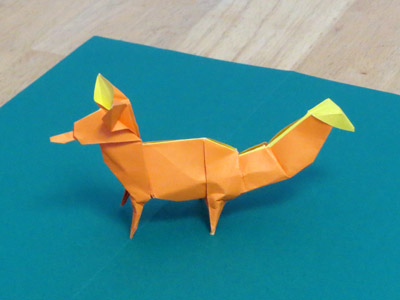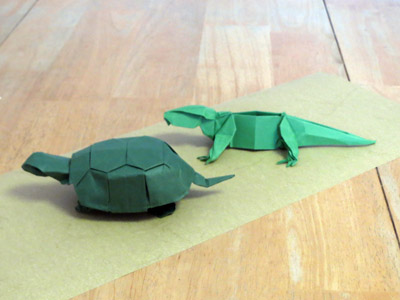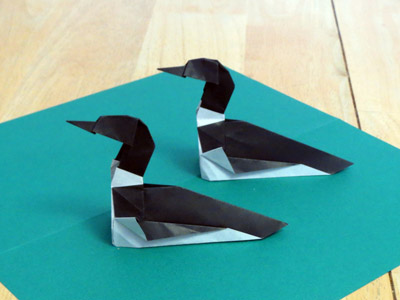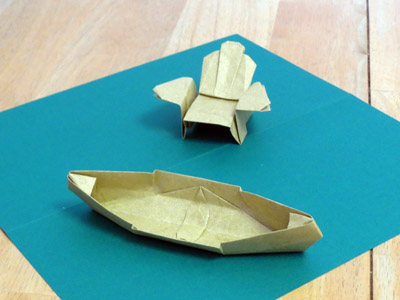The great folds over at Adirondack Life Magazine put up a feature on my book, Origami Animal Sculpture, on How to Make an Origami Adirondack Chair. Enjoy!
Tag: Origami Animal Sculpture
Adk Origami at The Bookstore Plus
Here it is. The good folks at The Bookstore Plus put a nice display of my book and the models I sent them. While they were at it they also had an origami contest. Congratulations James!
Adirondack Origami Exhibition
Up in Lake Placid, not far from North Pole, NY, there’s a really cool bookstore called The Bookstore Plus (www.thebookstoreplus.com). A while back they contacted me asking if I could to a book signing there for my new origami book, Origami Animal Sculpture. This I thought was very cool because my book has a strong Adirondack connection. Unfortunately Lake Placid is a pretty long trip for me and I haven’t been able to schedule a time yet. So instead I did the next best thing and sent them a box of origami they could use to make a display to help promote the book. No word yet from them on whether it arrived or what exactly they plan to do with it. But if you’re in the Placid area and you happen to pop in, please take a look. I’d love to see how it turned out.
Origami Interview
They’re promoting my book Origami Animal Sculpture over at Cut Out and Keep. Here’s the url:
http://www.cutoutandkeep.net/books/origami-animal-sculpture
The article includes an interview with yours truly, reprinted below.
• Hey John, can you introduce yourself to our readers?
Yeah, hi! I’m John Szinger, origami artist and author of Origami Animal Sculpture.
• Tell us a bit about Origami Animal Sculpture and what kind of projects we can expect?
Sure. It’s an origami book that features mainly animals, as the name would suggest, with an emphasis on the sculptural qualities of the models. The book features step-by-step instructions for twenty-two projects, and a discussion that touches on origami design, choosing paper, and finishing the models. It also features some great photography by my friend Bob Plotkin, of models folded by yours truly. There’s a DVD demonstrating the folds for people who feel more comfortable doing it that way. The book is meant for folders of an intermediate level and up. But there’s a bit of a progression to it. If you’ve mastered a few basic folds you could probably tackle at least a few of the projects in the book, then move on to the more advanced projects to increase your skill and artistry.
• What was the inspiration / where did the idea for the book come from?
I think animals are a great subject. They’re interesting and often challenging to fold, and there’s so many ways to approach the design. And of course being part of nature, animal designs bring out that natural connection. About half the models are based on the kind of creatures you can find camping and going on hikes around New York and New England: bears and moose, frogs and lizards, inchworms and butterflies. These kinds of creatures are near to my heart, and some were even designed on camping trips. Others such as the Narwhal and the Cuttlefish, are creatures I think are just plain cool.
• Which is your favourite project in the book?
I like ’em all, but a few are special for different reasons. The Lizard was one of my earliest successful designs. In fact I came up with it in a class on origami design. After that I was off and running. The Fox and Inchworm are charming. The Adirondack Moose is pretty cool, and so is the American Turkey. That’s the most complex model in the book and took me a while to really perfect.
• What is your craft space / writing space like?
I have an office/studio in my house. I’m also a musician and software designer so it’s full of saxophones, synthesizers and computers too. There’s origami all over the place, ideas I’m working in a big pile on a desk and a table, and in boxes. When I was doing the photos and videos for the book I built a little setup with lights and backdrops and a camera. You can fold just about anywhere, so I’ll do it sitting around the coffee table or whereever. Sometimes on the train. When I’m doing a big, intense piece or series, or wetfolding, I’ll set up on the kitchen table and go late into the night. The rest of my house is full of origami too, but most of that is finished pieces. My current favorites or newest stuff always go on top of my piano. That way I can look at them until I decide I’m satisfied with a piece.
• Have you always been creative?
Yeah, you could say that. When I was a kid I was really into drawing, and thought I would be an artist or comic book illustrator, or maybe do album covers when I grew up. I loved drawing monsters and spaceships, action-oriented kinds of things. Later I studied drawing animals and human figures, and that helped me down the line with origami, developing the eye for the subject. I also studied drafting, which helped alot when it came time to diagramming my origami.
• When did you first start crafting and can you remember the first thing you made?
Hmmm, my mom is into sewing and knitting and crossstich, so doing crafty stuff was always around when I was growing up. I remember doing paper airplanes and other kinds of paper crafts as a little kid. I came to prefer origami cuz of the simplicity: no cutting or gluing or stapling. In third grade or so I started doing origami out of books in the local library, but after a while I had folded everything I could find and I put it aside. I didn’t really come back to origami until many years later. I attended a origami convention mostly out of curiosity. I was amazed at level to which it had advanced as an art form, and found a really friendly community. I started making my own designs and participating in exhibits. I got hooked.
• Who are some of your favourite authors and crafty heroes?
I read lot of different kinds of books. Lately I’ve been into history and particularly biographies. Famous people always have interesting lives and you can learn alot about the times they lived in, and often something about what it takes to become successful. The last two books I read were the autobiographies of actor Arnold Schwarzenegger and singer David Lee Roth. Funny enough, both cite Teddy Roosevelt among their heroes. I read his autobiography earlier this year.
As for crafty heroes, I’ve always admired people who could fuse the technical and creative sides of their fields. For example, early in his career Walt Disney made some major contributions to the field of animation with synchronized sound, color, multi-plane animation and rotoscoping. He was never a really great cartoonist but was able to build a world empire starting with his cartoons. Similarly, when Pixar started out they were known for a product called Renderman that let you render your animation on a network of computers instead of a single computer, which made things go much faster. They were making short films to show off their technology, and it took off from there. On an individual level many great artists have developed new techniques to advance the expressiveness of their art form: John Coltrane, Picasso, the list goes on.
• Where do you look for inspiration?
Well for animals and natural subjects, the starting point is always nature itself. That’s a big part of my work and something I keep returning to. Within the origami world there’s lots people doing amazing work, different styles, different subjects, and often I’ll see something and think I’d like to try something like that. But you can’t try everything, there’s too much, so you have to choose, find your voice. Once you get into something and begin to understand, you look for a way to develop it and make it your own. Origami is very geometric art form and there’s a there’s a whole side that’s not at all representational, but strictly geometric. Tessellations, polyhedra, that sort of thing. I do alot work in that area too. That comes from nature too in a way, but more crystals than biology. Another stream of ideas comes from the world of graphic design, and various stylized art forms like stained glass or folk art.
• What’s next for you?
I just finished my first book, so I’m starting to think about book number two. I’m always experimenting, thinking about new subjects I’d like to tackle, and how I’d approach them. For a complex subject the actual hard work — folding better and better failures over and over — can get fairly intense so it tends to come and go in waves that might last a few weeks. I have maybe 50 or 60 models right now beyond what’s been published. I had to take a break from diagramming after finishing the book, but I’m back to diagramming again. I teach origami classes a few times a year at different events and its always nice to show up with something new to see how people respond. After I’ve diagrammed a model I’ll pass around the diagrams to see how people do. If they tend to have trouble with a particular step or sequence I’ll go back and rework that.
But the question is really to develop a theme. I have a few series of models that run together that could be the nucleus of a book. Whatever I pick, I have only about about a half a book’s worth, so I’d have to come up with a good number of new models. For one I have more animals, including a very nice cat and dog that seem to be popular. Developing this would lead me in a less complex direction that might have broader appeal. Another is mythological and fantastic animals. I have a Dragon and a War Elephant with a castle on its back that are among my favorite models, but they didn’t fit in with the first book. A third thread is my spaceships and airships, which have an unusual folding technique as well as a novel subject matter. Another thing I could do is a book on the tessellations and polyhedra. Some of the polyhedra are incredibly hard to fold, and to diagram. So I’m thinking of ways to make that work, to get it across to people. One idea is to use photos instead of diagrams in the final stages. I’m also working on developing a story-oriented book in collaboration with Bob my photographer. Whatever I pick, that’s going to be my main focus for the next year or two. So right now I’m just sort of looking and thinking before I dive back in.
Origami Animal Sculpture Reviewed at Gilad Origami
My book Origami Animal Sculpture has been reviewed by Gilad over at Gilad’s Origami Page (http://www.giladorigami.com). For those of you who don’t know, Gilad has a pretty comprehensive origami site with lots of reviews and galleries and an expansive database of lots of different models (by subject) telling you where you can find diagrams to fold such a thing.
He says of my book: “John Szinger has a knack for creating complex-looking designs with ample attention to details, which are actually not incredibly complex to fold. The models … using an innovative array of folding sequences, are well-designed, maximizing the surface of the paper and making them suitable for folding from almost any type of paper.”
I consider this great praise, as that’s pretty much what I’m going for. You can read the full article here:
http://www.giladorigami.com/review-origami-animal-sculpture-szinger.html
Gilad has also folded and photographed several models from the book. I particularly like his rendition of my Brown Bear. It has a really nice snuffling quality.
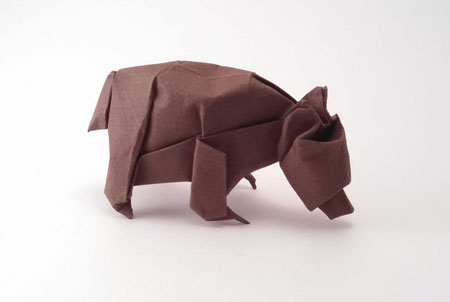
Origami Weekend
Just got back from another OUSA convention. This one was extra special because my book, Origami Animal Sculpture, made it’s debut for advanced sale at the Source and at Kinokuniya. It looks like the book is a hit among the OUSA crowd, and maybe even in the wider world. Friday I folded most of the day, and got my exhibit together. I finished my American Turkey with color change, folded from a sheet of Wyndstone laminated on side with red tissue. I started this model around the time I was doing the photography for my book but didn’t finish it in time, so it’s been sitting in a box. All that was really left to do was the final sculpting, which went just fine once I started it. I also finished the design for my Butterfly Mark II and folded a small flock of them.
Once I got to the convention and set up my exhibit I went straight to the Source to get a copy of my book. I’m pretty sure the advanced copies sold out over the weekend, based on the number of people who came up to me to ask me sign theirs. I think people really respond to the wildlife theme, and to the fact that the models have a lot of character and detail but are not too complex to fold. It was really fun and nice, all the support and positive vibe from my origami colleagues.
Saturday I did the book signing event at Kinokuniya. I actually got a pretty good sized crowd and informally taught models out of the book the whole time, held and audience, and even signed and sold a few books. These are intermediate level models for a general audience, so I’m glad they went over. Bob my photographer was there, and so was Jon my publisher and they met for the first time, and afterwards we went to lunch. It was a very interesting discussion covering various aspects of publishing and printing and the book biz. Jon stressed the importance for getting some social media buzz going to try and ignite online sales. We also talked about potential themes for a second book, and he mentioned the idea of simple models to appeal to a wide audience outside the origami community.
My Saturday class was my Foxy Fox, and it was very full. I’m told it was the first class to sell out Saturday. I sometimes teach from diagrams, but this time I just demo-folded and used the class as an opportunity to hawk my book. Everyone finished and thought it was a wonderful model. I skipped a few of the fussy details, but this got me thinking more about how to simplify my models.
Saturday night I got into a long conversation with the master John Montroll on the subject of folding simpler models. My premise is that it’d be worth exploring but the models would still have to be interesting and have something to say, not just the some old traditional and/or crappy folds you’d find in say a desk calendar. And that would actually be a really good challenge. Always one step ahead, John said he’d working on a book of simple models and pulled out a stack of diagrams. The average model was maybe 8 or 10 steps and the longest was maybe 16. Very nice models too, the Bald Eagle in particular. Wow!
Sunday I taught my Adirondack Moose, again by live demo to promote the book. Again the class was pretty full, and this time it had critical mass of short-attention-span kids, who I had to tell several times to quit interrupting and just wait for the next step. This model was closer to complex than intermediate, but again they all finished and a few stayed after to work on the finer points of the sculpting.
Monday I went downtown and saw Uyen’s Surface to Structure exhibit at Cooper Union. I was really blown away at the whole thing. First of all, the space and presentation were just fantastic. It was a well lit gallery space, very open, very white, and the models were all displayed on simple stands, very minimalist. And second, the collection of models was the finest you’ll see anywhere, and quite a broad range at that. I feel honored to be included in an exhibition with classic Yoshizawa and all that other stuff. My stuff was well presented along with everything else, but when I got there I thought one of the models was a little off, so I waited until the guard started playing with his phone and the nudged it a little to one side. Far and away the best origami exhibition I’ve seen, and think Uyen definitely did the world a service by really raising origami to the level of fine art in the public eye. She also gave me a copy of the program, which was very nice too. Just as beautiful as the exhibition.
Monday afternoon I had some free time and started coming up with some simple models. It seems like a good direction to explore right now. At the very least I can come up with lots of models quickly, which is refreshing after spending weeks or even months on a single idea with the single-sheet polyhedra and tessellations. I did a version of my Butterfly II without legs that was about ten steps. Then I did a variation and it became a hawk. Now the trouble became every time I finish a design, I think maybe I’ve seen it somewhere before. So I took advantage of the opportunity to ask around. These two at least seemed to be truly new and original.
All in all another great convention. I always come away with my creative energy charged up with a bunch of new ideas. It’ll be interesting to see what develops in the coming year.
Origami Animal Sculpture at Kinokuniya and OUSA
It’s on! Advanced copies of my book Origami Animal Sculpture will be on sale at the OUSA convention at the end of June in NYC and at Kinokuniya bookstore in Manhattan. Trying to get some buzz going. At the convention I’ll be teaching models from the book: the Moose, the Fox, maybe some others, and at Kinokuniya I’ll be doing a book signing event on Saturday June 28 at noon. This is during the convention but not at a time when there are classes or other activities, so I hope I get a good turnout. The good people at Kino are also making available some exhibit space. So watch this blog for further announcements.
